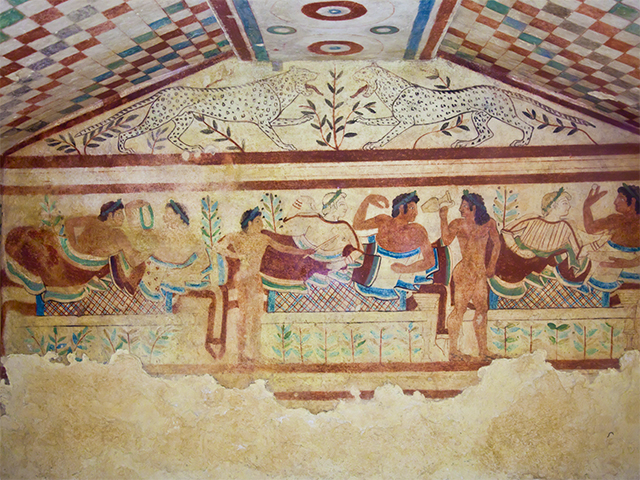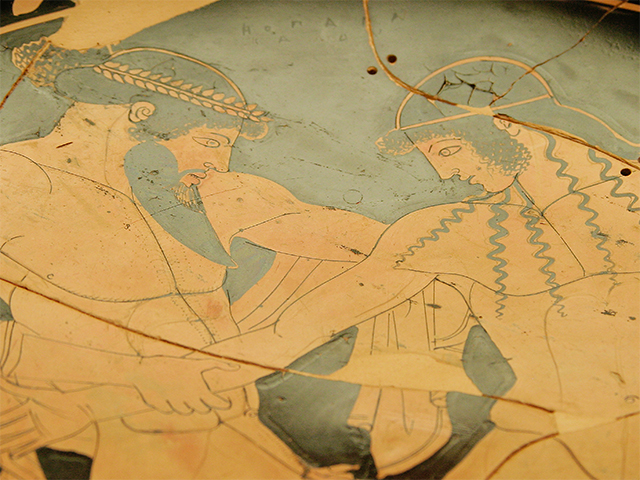10 Things to See in Tarquinia
What to see and do in Tarquinia: necropolis, museum, monuments to visit, where to go to the sea and ideas for your free time.What to see in Tarquinia? Center of Southern Etruria, symbol of Etruscan art par excellence, and Medieval town of great charm, Tarquinia has much to offer!
With precious monuments and museums, a charming and historic town center and important UNESCO's World Heritage archaeological sites, this beautiful city of Etruscan origins is a real concentration of art!
BOOK YOUR TOUR TO TARQUINIA FROM CIVITAVECCHIA
In addition, its strategic location and its proximity to major cultural centers and other cities of art make it a popular destination for tourists. You just need to think that Tarquinia is located just 15 minutes from the Port of Civitavecchia, 40 from Viterbo, 50 from Fiumicino Airport is little more than 1 hour from Rome.
Being aware that Tarquinia is much more than that, we will try, without any pretense of completeness, to tell you about its history through 10 unmissable places to visit. Follow Us!
1. ETRUSCAN NECROPOLIS OF MONTEROZZI
Visiting the Necropolis of Tarquinia is beyond doubt the best way to get to know the magnitude and at the same time the artistic refinement of the Etruscan people.
With over 200 depicted tombs, the frescoes of the necropolis of Monterozzi represent the wider existing pictorial collection of Etruscan art and at the same time the most important document of the whole ancient painting before the Roman imperial period.
The custom to decorate the graves of aristocratic families is documented even in other centers of Etruria, but only in Tarquinia the phenomenon has taken these dimensions: magical-religious scenes depicting funeral banquets, dancers, musicians and jugglers, all represented with harmonious movements and vivid colors.
An example of this are the Tomb of the Leopards, the Lioness, the Warrior, Hunting and Fishing, the Hunter, Cardarelli, of Lotuses and many others.
To learn more about the Necropolis and for more useful information on how to organize the visit read also the special article about the Necropolis of Monterozzi.
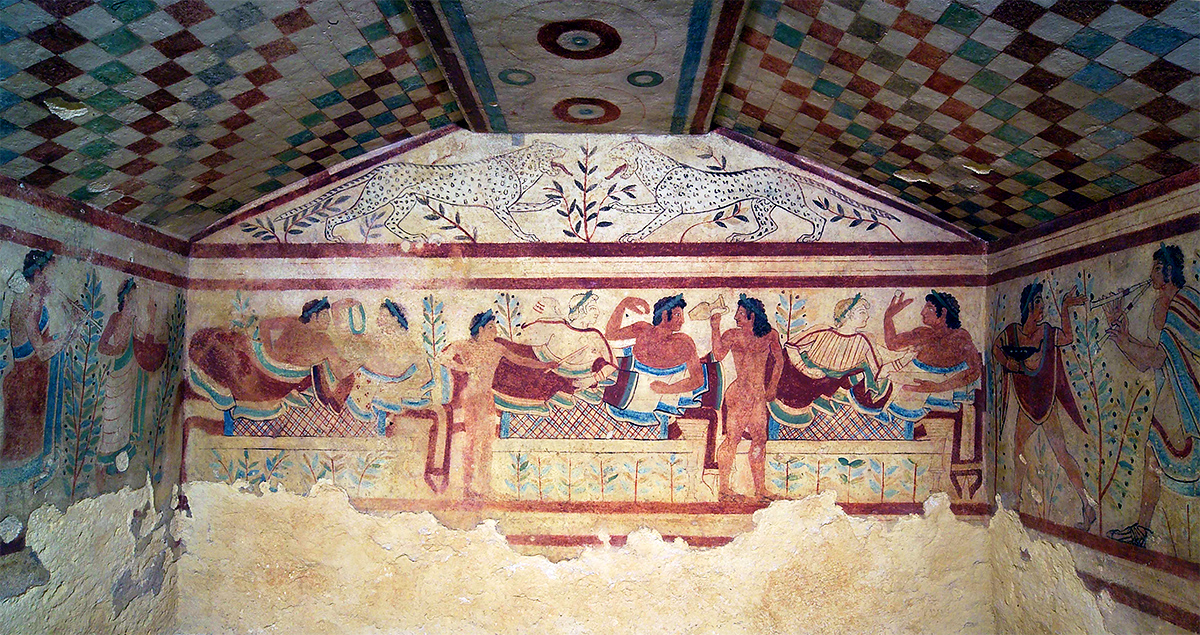
Etruscan Necropolis of Monterozzi - Tomb of the Leopards
2. NATIONAL ETRUSCAN MUSEUM OF TARQUINIA
Housed within Palazzo Vitelleschi, the National Etruscan Museum of Tarquinia is beyond doubt among the main attractions of the city.

Palazzo Vitelleschi - Tarquinia
The Palazzo Vitelleschi deserves a visit for itself!
Built by Cardinal Giovanni Vitelleschi between 1436 and 1439 with a design by Giovanni Dalmata, thanks to the simultaneous presence of Gothic and Renaissance elements and a true architectural masterpiece.
Inside, the exhibition is divided into three floors and contains the largest collection of Etruscan art exists. Sarcophagi, vases, bucchero ware, dishes, pottery, statues and ancient coins are only some of the important works that you can admire inside the museum.
The most significant work, the very symbol of the museum is without doubt the famous relief of Winged horses, recovered in the ruins of the temple of the Altar of the Queen.
Dating back to between the end of the 5th and the beginning of the 4th century b.c., this slab was found by archaeologist Pietro Romanelli, fragmented into one hundred pieces.
The first restoration, entrusted to Augusto Falessi, allowed to exhibit it only six months after its discovery (1938). Thanks to many further restoration workd, today we can finally enjoy this unique work in the world in all its splendour, enhanced even on the exhibition level, since it has recently been relocated in the original room.

Winged Horses of Tarquinia
3. HISTORIC CENTER AND MEDIEVAL CHURCHES
A nice walk through the narrow streets of the Historical Center of Tarquinia will take you back in time to a magical Medieval atmosphere between churches, monuments and historic buildings.
Starting from Barriera di San Giusto, the ancient entrance to the town, you will find yourself immediately in Piazza Cavour with the Renaissance palazzo Vitelleschi, seat of the Etruscan Museum. On your left Via G. Mazzini will lead you to Piazza del Duomo where you can admire the marvelous Cathedral of Santa Margherita (Saint Margaret) with its majestic bell tower. Continuing in Via Porta di Castello you will reach the beautiful Church of Saint Mary in the Castle, to which we have dedicated a separate paragraph.
Walk along the panoramic Via della Ripa and turn into Via delle Torri on which overlook beautiful historical buildings such as the Palazzo dei Priori and the Church of the Holy Spirit. Spend just a moment also in Piazza Santo Stefano where in addition to Tower Barucci is located the ancient washhouse.

Historical Center of Tarquinia
At the intersection with Via San Pancrazio you will find yourself in a small square where you can find the Church of San Pancrazio, the Torre del Magistrato and the beautiful Palazzo Castelleschi while taking Via San Martino you will find the church with the same name, the oldest in the city.
Continue along Via San Pancrazio up to the junction with Via dell'Orfanatrofio (Orphanage Street) and you will find yourself at the center, in Piazza Giacomo Matteotti where you will find the Palazzo Comunale, the monumental eighteenth-century fountain, the Church of San Leonardo and the Church of the Suffragio.
Finally from Via di Porta Tarquinia you reach the beautiful Church and the convent of Saint Francis or you can reach Piazza San Giovanni, where you can visit the Romanesque church of Saint John of Jerusalem.
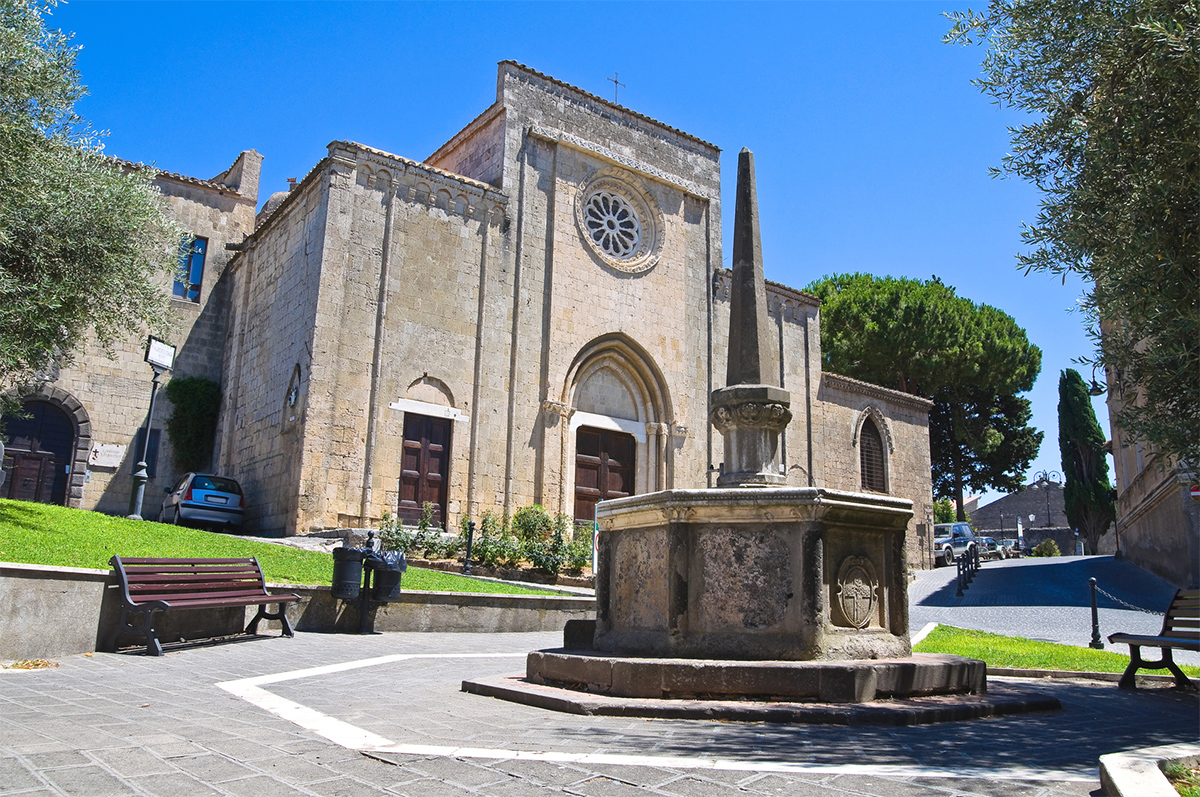
Tarquinia - Church of Saint Francis
4. THE KEEP OF MATILDE OF CANOSSA AND THE CHURCH OF SAINT MARY IN THE CASTLE
The splendid Romanesque Church of Saint Mary in the Castle deserves a chapter on its own. The church is situated in the oldest part of Tarquinia, where the Castrum Cargnetum was located, originating the nucleus of ancient Corneto.
To reach it, you have to walk along Via di Porta Castello, cross the ancient gate with the Tower of Dante and the Tower of Matilde di Canossa in the background. A few steps to be catapulted 1000 years back!
The atmosphere here is simply magical, especially at night when the streets are illuminated only by the light of the street-lamps... the ideal place for a romantic walk in history.
Read also our article about the church to deepen its history and know the works of art kept in it.
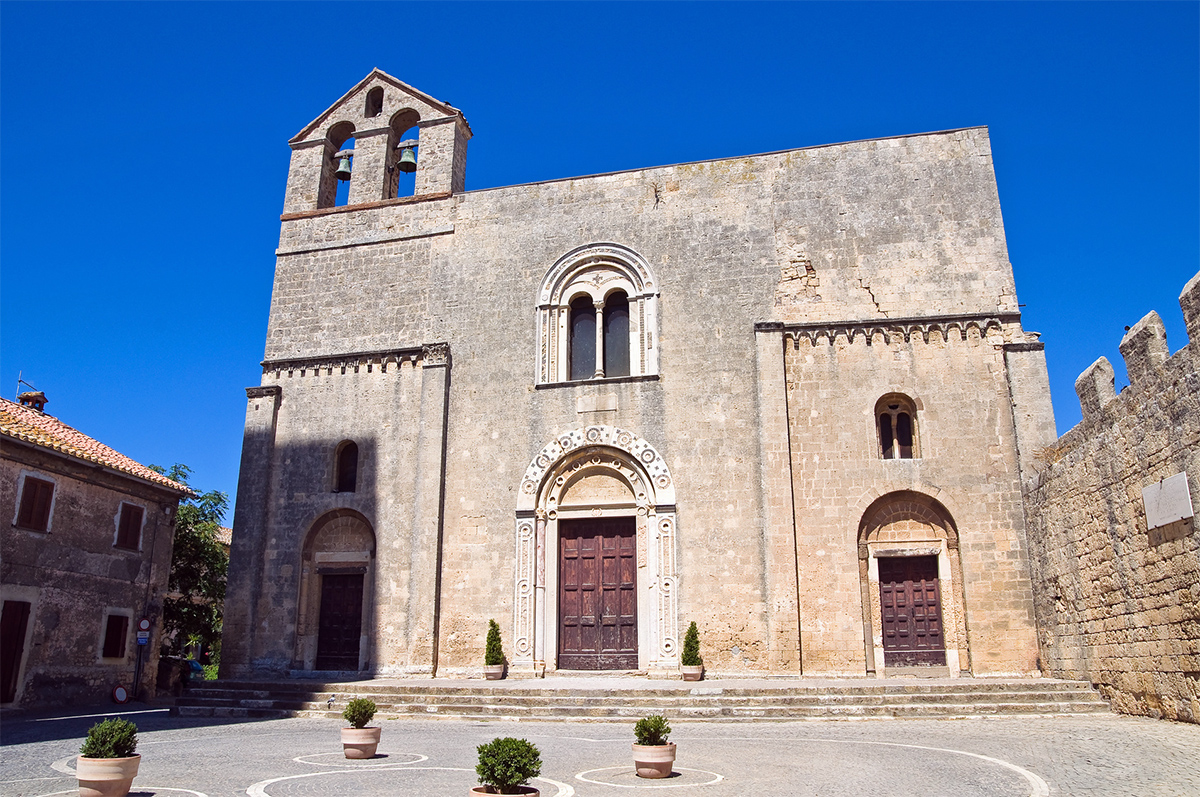
Tarquinia - Church of Saint Mary in the Castle
5. TARQUINIA CATHEDRAL
The Cathedral of Saints Margherita and Martino, built around 1260, is located in the square with the same name a few steps from Palazzo Vitelleschi and it is part of the diocese of Civitavecchia and Tarquinia.
Raised to the rank of Cathedral on 5 December 1435, during the fifteenth century the cathedral was enlarged by Bishop Bartolomeo Vitelleschi then it was unfortunately destroyed in 1643 by a terrible fire.
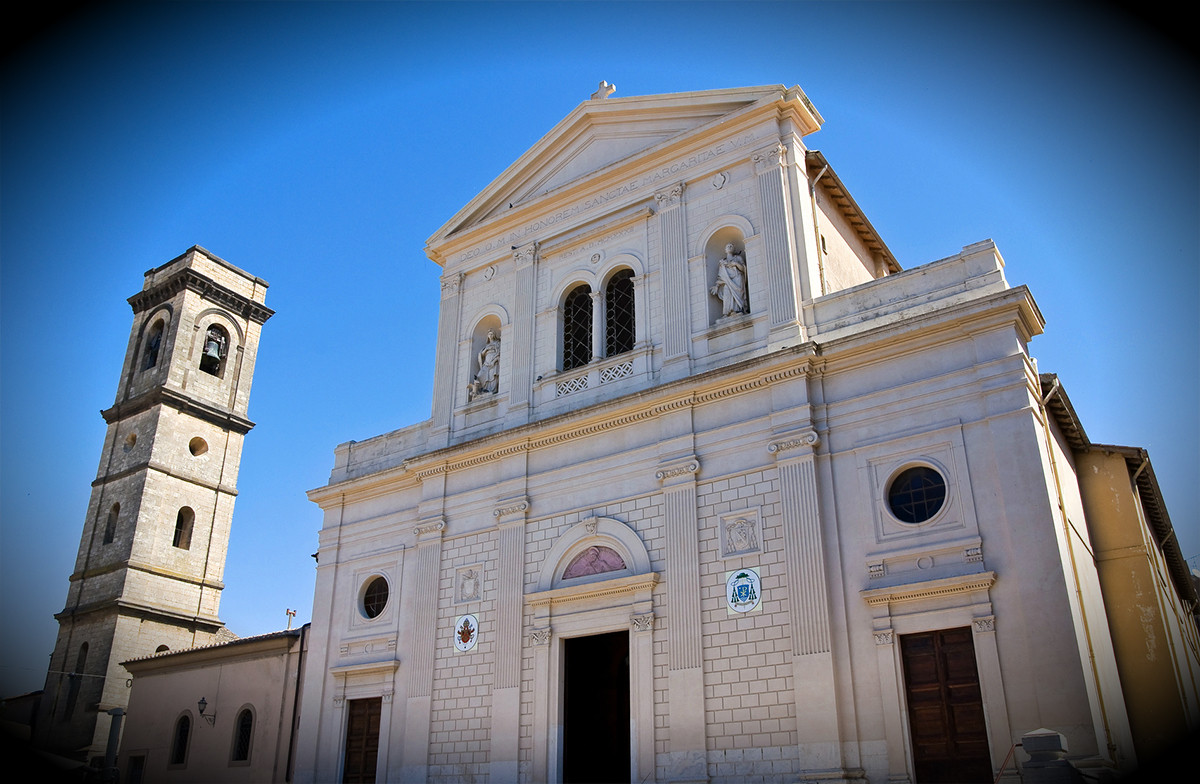
Tarquinia - Cathedral of Saints Margaret and Martin
Rebuilt in a short time, the Cathedral was once again restored in the nineteenth century in a Neoclassical style according to the project of Francesco Dasti and expanded adding nine altars.
Externally, the façade is preceded by a staircase and it is flanked on the left by a bell tower. In the lower part, there are three portals, while in the top, ending with a tympanum of triangular shape, is located a mullioned window flanked by statues of the two saints.
The interior, divided into three naves, preserves in the presbytery elements of the structure previous to the fire. Among the most beautiful works kept inside you can admire the frescoes of the choir made by Antonio da Viterbo, called Pastura (16th century), depicting the Stories of the Virgin.
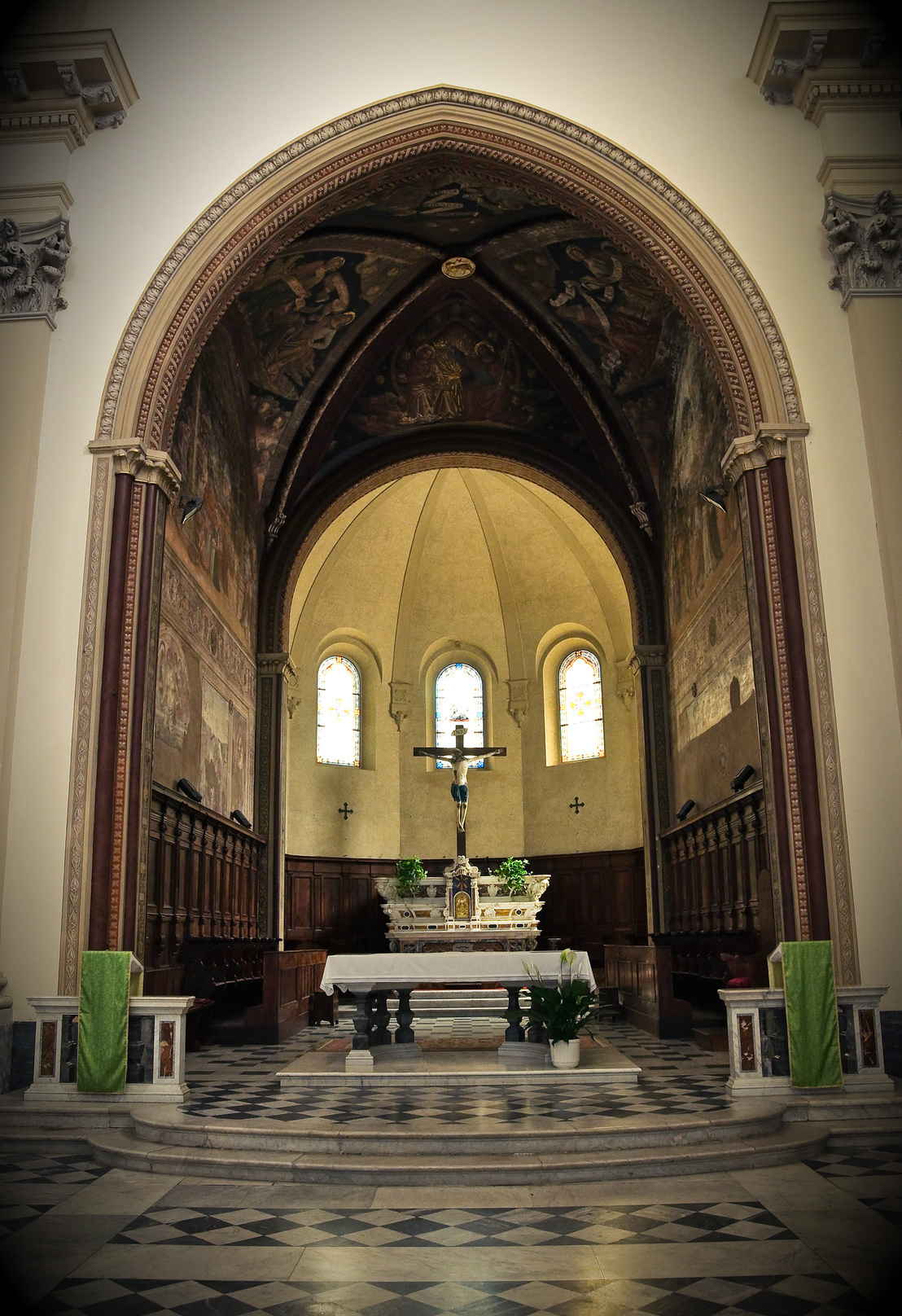
Tarquinia Cathedral - Interior
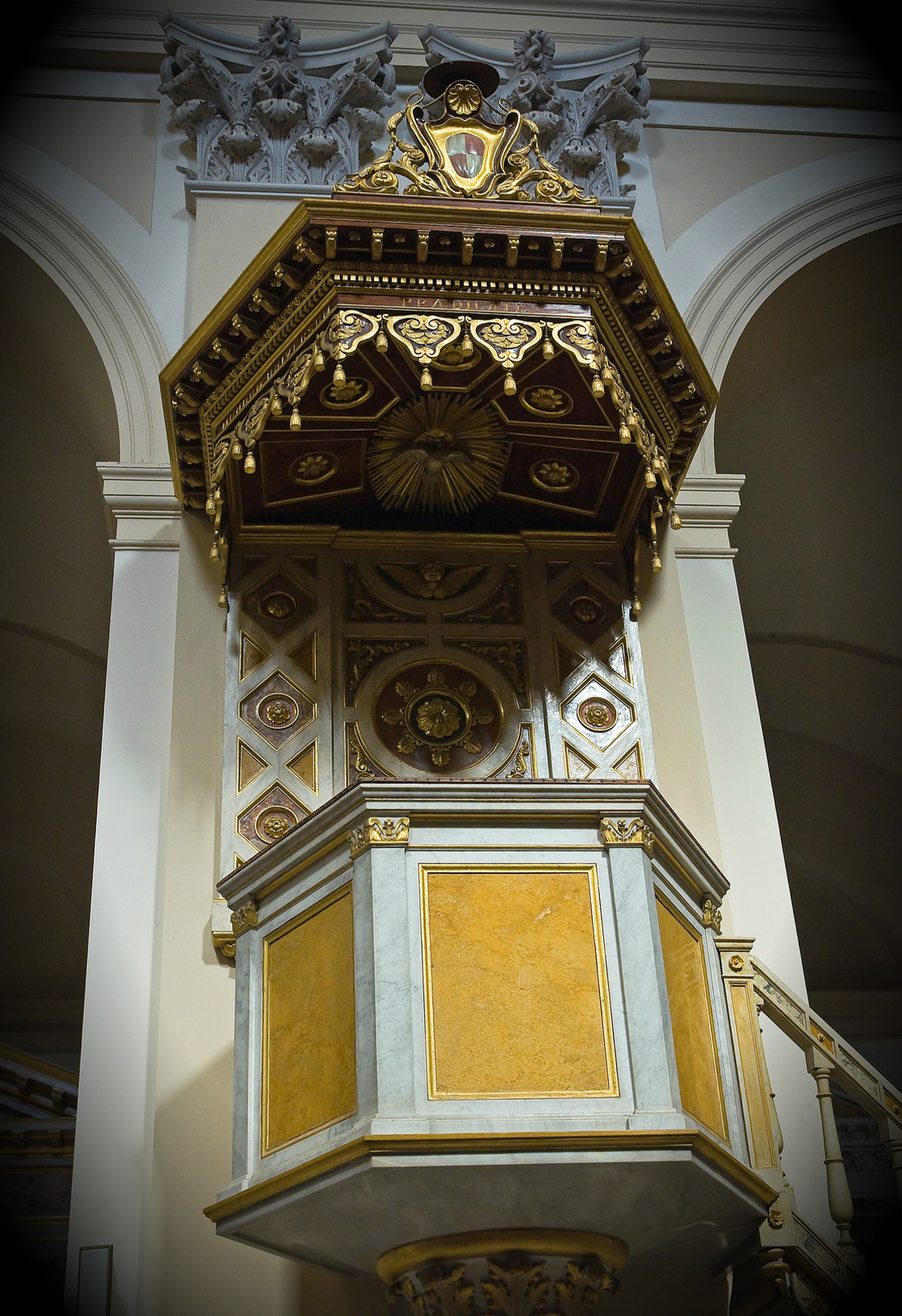
Tarquinia Cathedral - Interior
6. PALAZZO COMUNALE
The Palazzo Comunale of Tarquinia is situated in the heart of the Medieval historical center. Built in the 18th century its position assumes an important symbolic value as it stands along the route of the old city walls of which the tower was already part, a testimony of the past expansion of the city.
The building, predominantly of Romanesque style with Gothic elements, has two façades: one on Via San Pancrazio, the other, on Piazza Matteotti. In its interior is located the famous Hall of frescoes that in the past was a board room of the city council while nowadays it constitutes the antechamber of the mayor and it is used for ceremonies, civil wedding ceremonies and other public functions.
The beautiful paintings that fresco its walls (attributed to C. Donati) depict historical episodes and characters of the city and date back to between the 16th and 17th centuries.
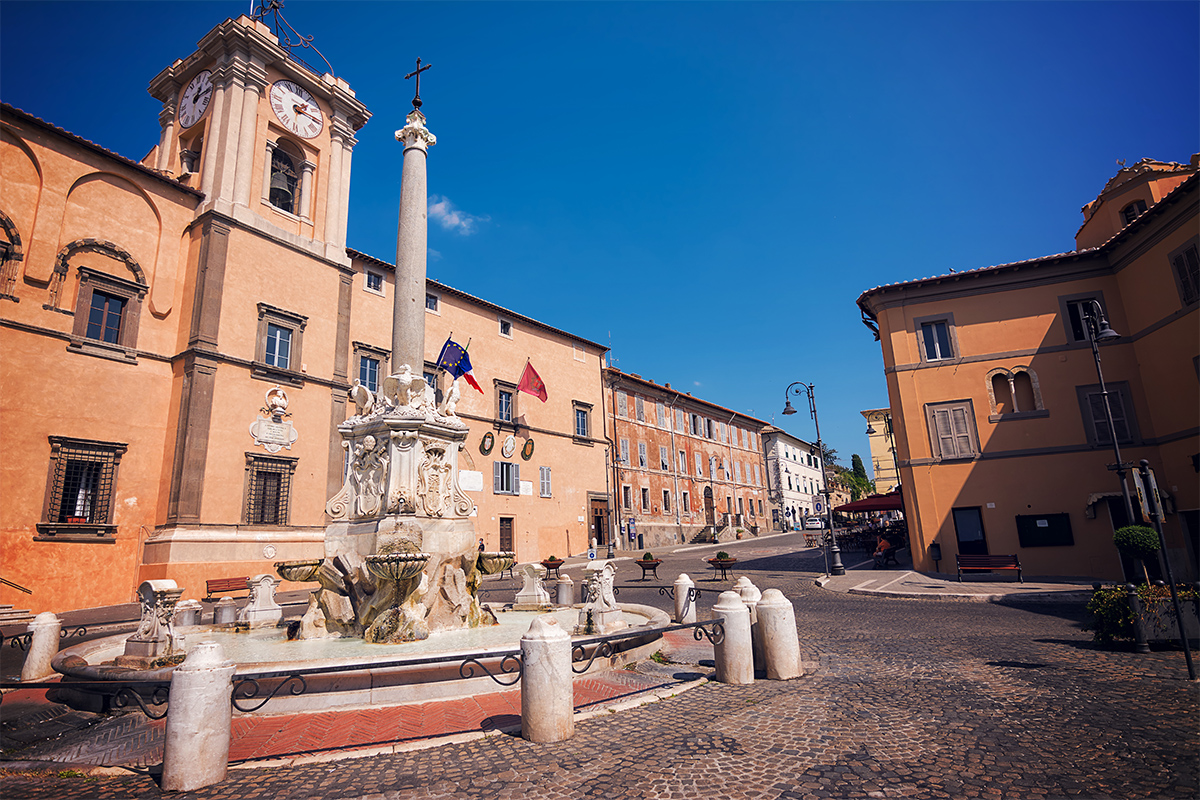
Tarquinia - Palazzo Comunale
7. OLD GRAVISCA (PORT CLEMENTINO)
Along the coast, between the mouth of the river Marta and the Salt Pans Reserve to the south, is the archaeological area of Gravisca, an ancient Etruscan port, area today known as Port Clementino, in honor of Pope Clement XIII who had it restored.
Before colonization by the Romans, who renamed the town as Gravisca, this maritime stopover was very frequented by foreign merchants, mostly coming from Asia Minor.
At the southern edge of the Etruscan center, in fact, they discovered traces of the so-called Greek Sanctuary of Gravisca. Founded between 600 BC and 580 BC, the sanctuary took soon the functions of Emporion, that is, it became the center of trade and also religious functions. There were venerated was, Aphrodite and Demeter in their Etruscan equivalents: respectively Ura, Vei and Tura.
Among the most significant finds found in the sanctuary is certainly the kantharos of Exechias, valuable Attic ceramics of the 6th century BC, together with an inscription to Apollo Egineta made by merchant Sostratos of Aegina, which testifies how the contacts with the Eastern Mediterranean and the Greek world were alive.

Ruins of Porto Clementino, ancient Etruscan Port of Gravisca
9. NATURAL SALT PANS RESERVE OF TARQUINIA
Located close to the coast of THE ancient etruscan town, the Natural Salt Pans Reserve of Tarquinia is an extremely important natural site, being the only salt pans in the Lazio region and one of the few remaining along the entire Italian coast.
Expanded for 150 hectares, of which about 100 made of coastal lagoon, the site welcomes all year a huge number of species of migratory birds including Pink flamingoes, Little Egrets, Gray herons, Black-winged stilts, Mediterranean gulls, White Herons and many others. In addition, you can also come across other nice specimens of foxes, porcupines, nutrias, hedgehogs, squirrels, and Hermann's tortoises.
Perfect place for photographers and birdwatchers the Salt Pans are managed by State Foresters and can be visited all year with prior reservation. To book, call +39 0766 864605 or write an email to pf.salineditarquinia@corpoforestale.it
If you are also looking to relax a little, close to the natural reserve you'll also find a free beach long about 4 km. If you otherwise want to discover some other sea towns close to Tarquinia continue reading this article!
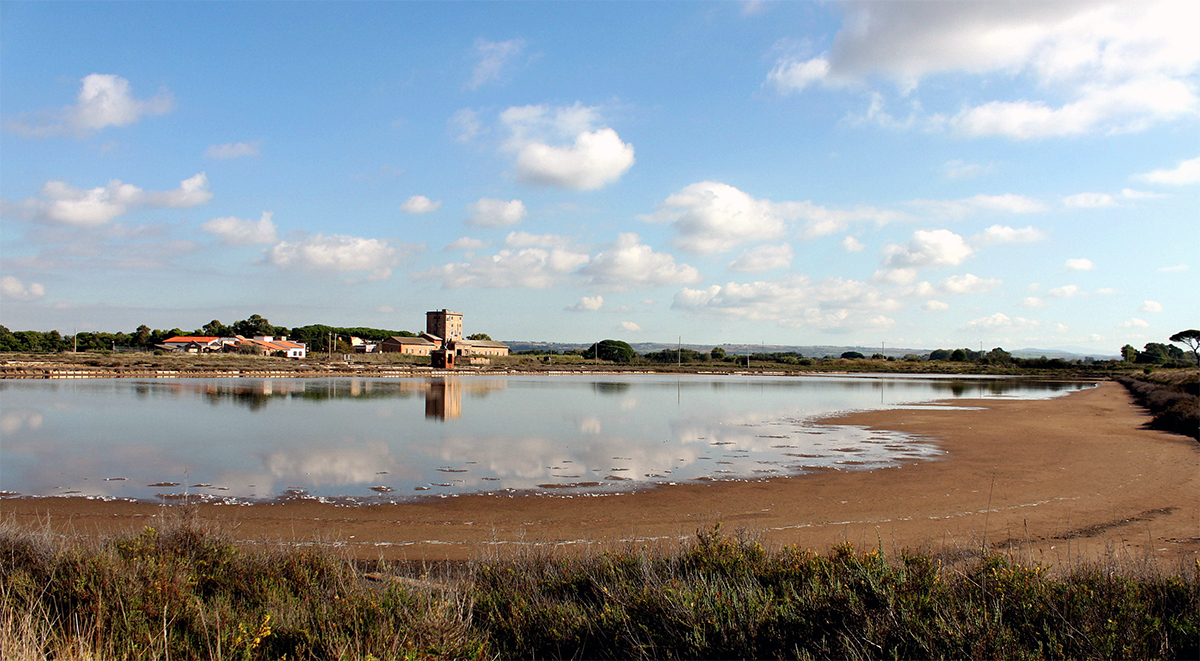
Natural Salt Pans Reserve of Tarquinia
8. LIDO DI TARQUINIA AND OTHER BEACHES
Tarquinia offers different alternatives for all sea lovers. The longer and better-equipped stretch of beach is represented by Lido di Tarquinia which, just 10 minutes away from the city center, is mainly frequented by families with children and sports enthusiasts who come here for surfing, windsurfing, sailing or to play beach-volley.
Marina Velca is a small beach located about 4 kilometers to the north of the Lido. Frequented by tourists of all ages and equally divided between equipped and free access beaches. Here you will find Pian di Spille, one of the most beautiful beaches of Tarquinia, also known as the large donut. 10 Kilometers of sandy coastline mixed with Mediterranean pine forests that surround a very nice sea where it is also possible to practice naturism.

Lido di Tarquinia
Riva dei Tarquini is a beautiful stretch of coast just north of Marina Velca, where besides going to the sea and you can practice many fun activities. In fact, here stands a great Campsite where in addition to usual camping services, there is a large adventure park and an Airsoft field.
About 7 km south of Lido, near the Natural Reserve of Salt Pans, there is the free beach of San Giorgio, probably the wildest of the coast.The beach is free and it is not equipped. To reach it one must pass an unpaved road in the countryside.
Finally, the beach of the Bagni di Sant'Agostino is especially famous for the dunes that alternate with dense pine forests. Located next to the contrada with the same name in the municipality of Tarquinia, approximately 15 kilometers from Civitavecchia, this beach of soft golden sand is characterized by a large and long coastline, which overlooks a small gulf behind which are dunes dotted with maquis.
10. WHAT TO EAT IN TARQUINIA: RESTAURANTS, WINERIES AND AGRITOURISM
Tarquinia boasts an enviable gastronomic culture which ranges from the most genuine flavours of the countryside to the sea cuisine offering a wide range for all tastes.
As it is natural, fish restaurants are mainly found along the beach of the Lido while in the hinterland you can find many restaurants, wineries and agritourism.
Among the most renowned local products deserve a special mention the vegetables including ferlenghi mushrooms, artichokes, tomatoes, peppers, fennels and asparagus but also other products such as durum wheat pasta, extra virgin olive oil, cheese, cold cuts, sausages, honey and excellent white and red wines.

Tarquinia is full of restaurants, winehouses and agrotourisms
Here we are, at the end of this article about Tarquinia, cradle of the Etruscan civilization and wonderful medieval city, included in Unesco's World Heritage List.
Certainly things to see and do in Tarquinia don't finish! We, not to write too long of an essay, have tried to summarise the beauties of this locality in 10 unmissable places... the rest is to you to discover for yourself!
Enjoy your trip!
Useful information
Tarquinia
- HOW TO GET THERE
- By trainFrom the Port of Civitavecchia you can go with about 10 minutes walk to the train station, take the first train (direction Pisa Centrale/Grosseto - €1.50) and get off after 1 stop in Tarquinia (Museum). For train timetables please refer to the Trenitalia website.By busFrom Piazza Vittorio Emanuele (Cathedral) you can take the Cotral line in direction to Tarquinia (Barriera S. Giusto) that will leave you a few steps from Etruscan Museum and the city center. For timetables please refer to the official site. Close to Largo della Pace and Fort Michelangelo you can also take the Eusepi Bus (except on Sundays), stopping at Barriera S.Giusto, close to the Etruscan Museum. From there you can take other buses to reach other tourist destinations in Tarquinia. Tickets costs €2 each way. For information about times please refer to the official site.By car- From Rome: take highway up to Civitavecchia and Statale Aurelia (90 km).- From Grosseto: Strada Statale Aurelia in the direction south (90 km).- From Viterbo: via Vetralla - Monte Romano or via Tuscania; in both cases not more than 45 km.



 PORT MOBILITY CIVITAVECCHIA
PORT MOBILITY CIVITAVECCHIA










